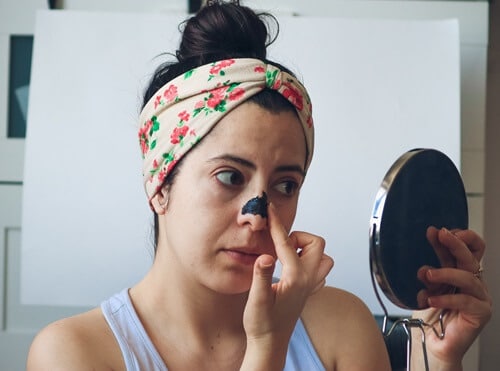Are you interested in mindfulness but don’t know much about it? Well, it’s surprisingly easy to get the wrong idea. There are many incorrect, yet all too common, beliefs about awareness.
For example, I used to think it was spiritual nonsense that didn’t have any benefits. In reality, this is exactly what mindfulness is not.
It’s being more aware of your surroundings and practicing more awareness of what you already do in your life. So you don’t let your life pass by without enjoying it truly, and recognizing what you neglecting in your life.
Let’s take a look at what mindfulness is not to help you get started on your journey. We’ll explore why these awareness misconceptions are so common and whether there’s any truth behind them. Finally, I’ll give you some tips so you can start practicing awareness right now.

Mindfulness vs. Mindlessness
Before we dive into what mindfulness is not, let’s take a look at what it is…
What is Mindfulness?
You may already know that being mindful simply means being present in every moment. As such, it can help us be engaged with and appreciative of how we feel and what’s going on around us.
What is Mindlessness?
Think of mindlessness as being on ‘autopilot’. In our daily lives, many of us are mindless by default. We work through our tasks while counting down the minutes until we can relax again.
If you don’t yet know how to be mindful then you can very easily slip back into mindlessness. If one thing is for certain, what mindfulness is not is mindlessness.
Mindlessness = Misconceptions
The difference between mindfulness and mindlessness leads to some very common misconceptions. Because it’s the opposite, many people believe that it can ‘fix’ their lives.
On the other hand, some believe that mindfulness is a state of zen that takes years to achieve. This can lead you to avoid it and be content with your mindless ways.
Let’s take a closer look at some of these misconceptions and find out exactly what mindfulness is not.

1. What Mindfulness is Not: Laziness
A big part of mindfulness is accepting the present moment. In fact, acceptance is one of the 7 principles of mindful behavior.
Due to this, many individuals think it means never changing, doing, or creating anything. It’s commonly believed that, instead of solving their problems, mindful individuals will just accept things and move on.
This is not true.
Mindfulness can be a big help if you feel stressed or buried under your problems. Yes, by accepting these issues, you can say goodbye to stress and anxiety. But don’t forget that mindfulness can improve your motivation and help you make better choices.
It’s been proven that mindful people are more likely to pursue individual goals. Then, when they achieve these goals, they feel happier and even more motivated. So, you can find solutions to your problems with improved motivation and acceptance. At the very least, mindfulness lessens the negative effects that these issues have on your happiness.

2. What Mindfulness is Not: Self-Care
Okay, perhaps this one is true in some way. A 2012 study in the Clinical Psychology Review found that mindfulness leads to “higher levels of positive affect, life satisfaction, vitality, and adaptive emotion regulation.” In this way, mindfulness is indeed a form of self-care because it can improve your wellbeing.
Still, many individuals believe that mindfulness is about relaxing all the time. This is often because a large part of mindfulness is the connection between your mind and body.
However, giving yourself exactly what you want whenever you want it is what mindfulness is not. Instead, mindfulness encourages a reflective process. Equally, it’s about questioning why your mind or body wants something and finding out whether that thing will truly benefit you.
To add to this, mindfulness helps you refocus away from material things and onto the emotional roots of your wants and needs. For example, if you’re focusing on why you haven’t had a pay rise at work, mindfulness will help you pay attention to how you can be more productive.

3. What Mindfulness is Not: A Religious Practice
Mindfulness does have roots in Buddhism, so this misconception is understandable. After all, I used to believe this one myself. For example, professor of communication, media and public policy at Northeastern University, Matthew C. Nisbet, explains that:
“The concept of ‘mindfulness’ traces to the Pali words sati, which in the Indian Buddhist tradition implies awareness, attention, or alertness, and vipassana, which means insight cultivated by meditation.”
However, you don’t have to be a Buddhist to be mindful just because it originally came from Buddhism. In fact, around 14.2% of people practice mindfulness in the USA, according to a 2017 survey. That’s 37.95 million people! Whereas, only about 1% of the population are practicing Buddhists.
4. What Mindfulness is Not: Just Meditation
Leading on from that, it’s easy to think that awareness is all about meditation. Actually, meditation is simply a useful tool to get into a mindful state.
Meditation anchors you in the present moment because it helps you focus on your breathing and body. Additionally, letting your thoughts pass by without distracting you promotes mindful acceptance and letting go.
According to the National Center for Complementary and Integrative Health, meditation has other benefits too. These include decreased blood pressure, reduced anxiety, and deeper sleep. But, meditation is not the only tool for helping you feel mindful. If you struggle to meditate, why not try…
- Listening to music
- Dancing or practicing movement therapy
- Take a walk in nature or around your garden
- Doing a puzzle, sudoku, crossword, or other cognitive activity
- Writing in a diary or scrapbooking

5. What Mindfulness is Not: A Quick-Fix
Mindfulness can indeed have some incredible benefits. Increased focus, creativity, and happiness are all things mindful people enjoy.
However, this does not mean you can decide to be mindful one morning and your life will instantly get better. A simple, quick, cure-all is what mindfulness is not.
But, don’t despair. According to a study in the journal Brain and Cognition, to begin to feel its effects, you only need to practice mindfulness for about 8 weeks. Plus, a 2023 study has since found that to improve your mental well-being with it takes as little as 2 weeks.
How to Avoid Mindlessness and Embrace Mindfulness
Now you know exactly what mindfulness is not. So, it’s time to find out for yourself what mindfulness is. With the above in mind, let’s explore how you can start being mindful right this very moment…

A Body Scan
All too often, we go about our days ignoring aches and pains, itches, or other bodily sensations. Performing a body scan is an easy way to feel grounded in the present moment.
Start with your toes, and move through your body until you end at the top of your head. Flex each body part, and find out how they feel and what would make them feel better.
Sensory Questions
Another simple way to practice it is a sensory check-in. Ask yourself what you can see, touch, smell, hear, and taste right now. Practice sensory check-ins throughout your day.
Soon, you’ll find yourself noticing things you may never have seen, heard, or felt before.

Mindful Eating
During your next meal, don’t eat just to give yourself energy. Instead, focus on how the food looks, smells, and feels in your mouth. Don’t forget to your time and concentrate on each bite.
What is the temperature like? Is it sweet or more salty? Are you satisfied or will you need to eat more?
Gratitude Journalling
Grab a notebook and a pen, and jot down a few things you’re grateful for and why. Focus on the positive and try not to think about things you’d like to change.
This will help you appreciate how you feel in the present moment. Due to this, it’s a great exercise to try if you’re feeling stressed out, anxious, or hopeless. Not to mention, when you’re feeling mindless, you can return to this notebook and take on a mindful state.

Stretching
Find some basic stretches that will help you loosen up and relax. Concentrate on how your body feels as you move it. You can even stretch during your body scan.
Make sure to only push yourself as far as feels comfortable. Don’t judge yourself if you’re feeling especially tired today or can’t touch your toes, hold stretches for long, etc.
In Conclusion
It’s just as important to understand what mindfulness is not as to understand what it is. This is because the myths above might lead you to practice it incorrectly. Or, even worse, holding onto these misconceptions may mean you don’t try to be mindful at all.
Key Takeaways
- Mindfulness is about acceptance. But, being lazy is what mindfulness is not.
- Mindfulness can be an important part of self-care. But, you shouldn’t let it lead to hedonism.
- Buddhists practiced meditation to lead to a mindful state. You don’t have to be religious to be mindful.
- Mindfulness is not confined to meditation. You can be mindful no matter what you’re doing.
- Mindfulness won’t solve all your problems right away. However, it will certainly help you make a start.
- You can start being mindful right now with a sensory check-in or body scan.
Remember, it doesn’t have to take up a lot of your time. Like mindlessness, it is a state of being. However, if you’re used to mindlessness, it’s going to take some practice to become fully aware.
Now that you know what mindfulness is not, it will be much easier to start your mindful journey. If you still don’t believe me, try some mindful activities in the coming days.
Now It’s Your Turn: Did you have any misconceptions about mindfulness before you tried it? I’d love to hear about the mindful activities that changed your mind and what benefits you’ve experienced.
References
Books
Kabat-Zinn, J. (2013) Full catastrophe living: Using the wisdom of your body and mind to face stress, pain, and illness. New York: Bantam Books Trade Paperbacks.
Journals
Cillessen, L., Johannsen, M., Speckens, A. E. M., & Zachariae, R. (2019). Mindfulness‐based interventions for psychological and physical health outcomes in cancer patients and survivors: A systematic review and meta‐analysis of Randomized Controlled Trials. Psycho-Oncology, 28(12), 2257–2269. doi:10.1002/pon.5214
Fincham, G. W., Mavor, K., & Dritschel, B. (2023). Effects of mindfulness meditation duration and type on well-being: An online dose-ranging randomized controlled trial. Mindfulness, 14(5), 1171–1182. doi:10.1007/s12671-023-02119-2
Gotink, R. A., Meijboom, R., Vernooij, M. W., Smits, M., & Hunink, M. G. M. (2016). 8-week mindfulness based stress reduction induces brain changes similar to traditional long-term meditation practice – a systematic review. Brain and Cognition, 108, 32–41. doi:10.1016/j.bandc.2016.07.001
Intarakamhang, U., Macaskill, A., & Prasittichok, P. (2020). Mindfulness interventions reduce blood pressure in patients with non-communicable diseases: A systematic review and meta-analysis. Heliyon, 6(4). doi:10.1016/j.heliyon.2020.e03834
Kappes, C., Marion-Jetten, A. S., Taylor, G., Schad, D. J., Dreßler, B., El-Hayek, S., … Stach, P. (2023). The role of mindfulness and autonomous motivation for goal progress and goal adjustment: An intervention study. Motivation and Emotion, 47(6), 946–964. doi:10.1007/s11031-023-10033-2
Keng, S.-L., Smoski, M. J., & Robins, C. J. (2011). Effects of mindfulness on psychological health: A review of empirical studies. Clinical Psychology Review, 31(6), 1041–1056. doi:10.1016/j.cpr.2011.04.006
Richter, N., & Hunecke, M. (2021). The mindful hedonist? relationships between well-being orientations, mindfulness and well-being experiences. Journal of Happiness Studies, 22(7), 3111–3135. doi:10.1007/s10902-021-00358-5
Websites
(N.d.). Retrieved from https://www.nccih.nih.gov/health/meditation-and-mindfulness-what-you-need-to-know
Clarke, T. C., Barnes, P. M., Black, L. I., & Stussman, B. J., Nahin, R. L. (2018). Retrieved from https://www.cdc.gov/nchs/data/databriefs/db325-h.pdf
Grant, D. (2022). Retrieved from https://www.dayagrant.com/blog/does-mindfulness-make-you-lazy
Haupt, A. (2023). Retrieved from https://time.com/6249527/how-to-be-mindful-hate-meditating/
Headspace. (n.d.). Retrieved from https://wellnessatnih.ors.od.nih.gov/Documents/Boosting%20Productivity%20at%20Work%20How%20Mindfulness%20Training%20Helps%20(002).pdf
Nisbet, M. (2017). Retrieved from https://web.northeastern.edu/matthewnisbet/2017/05/24/the-mindfulness-movement-how-a-buddhist-practice-evolved-into-a-scientific-approach-to-life/
PRRI Staff. (2021). Retrieved from https://www.prri.org/research/2020-census-of-american-religion/







